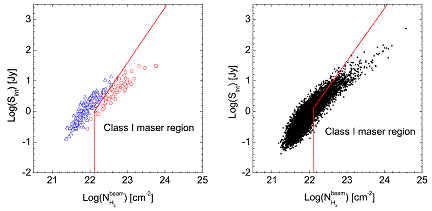
(by with XU Ye)
The first research work by using the new installed Superconducting Spectroscopic Array Receiver (SSAR) of 13.7m telescope in Delingha was accepted by ApJ Supplement. The authors are mainly from Shanghai Astronomical Observatory, University of Tasmania, Yunnan Observatory and Purple Mountain Observatory.
Methanol masers from a number of transitions are common in active star forming regions(SFRs) and have been empirically classified into two categories (class I and class II). Class I methanol masers are less well studied than class II masers, but have recently become the focus of more intense research. Further searches for class I methanol masers are very important for our understanding of the range of environments and circumstances in which they arise.
An overall of 214 target sources were selected by combining information from both the Spitzer GLIMPSE and 1.1 mm BGPS survey catalogs. For the majority of detections (43), this is the first identification of a class I methanol maser associated with these sources. They show that the intensity of the class I methanol maser emission is closely correlated with properties (mass and beamaveraged column density) of the BGPS sources.
On the basis of this observation, they developed a new criteria for targeting class I methanol maser searches (Figure 1). Their expectation is that searches using these criteria will detect 90% of the predicted number of class I methanol masers from the full BGPS catalog (1000), and do so with a high detection efficiency (75%). Refer to http://arxiv.org/abs/1202.6478 for details. |
